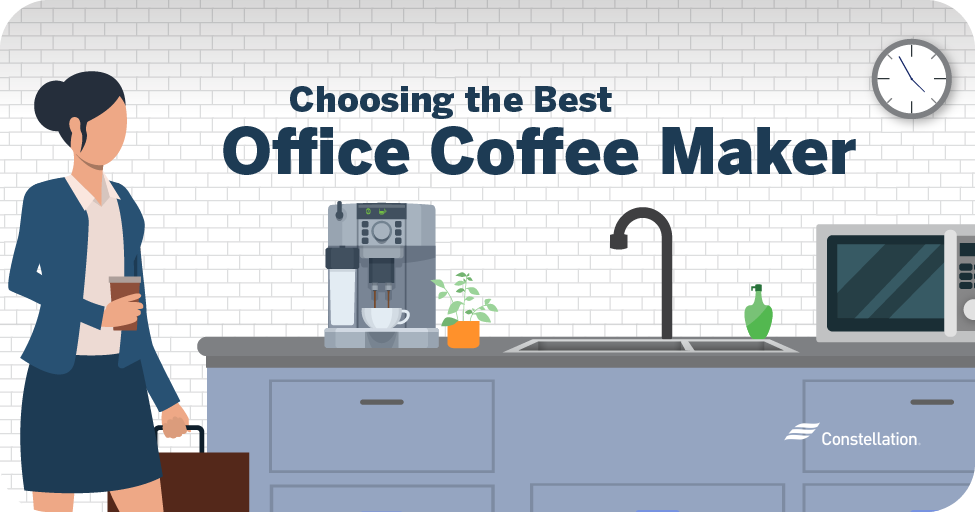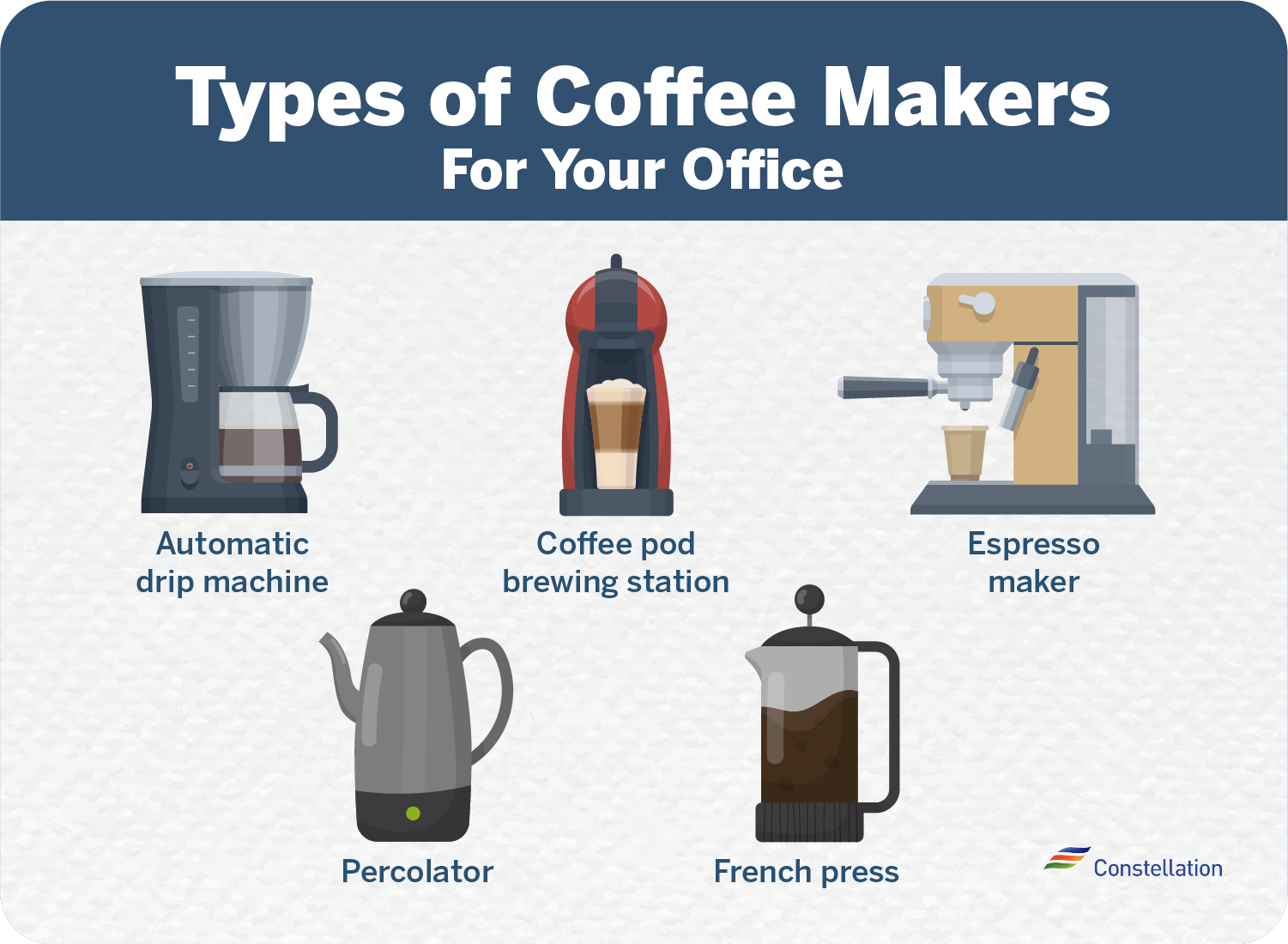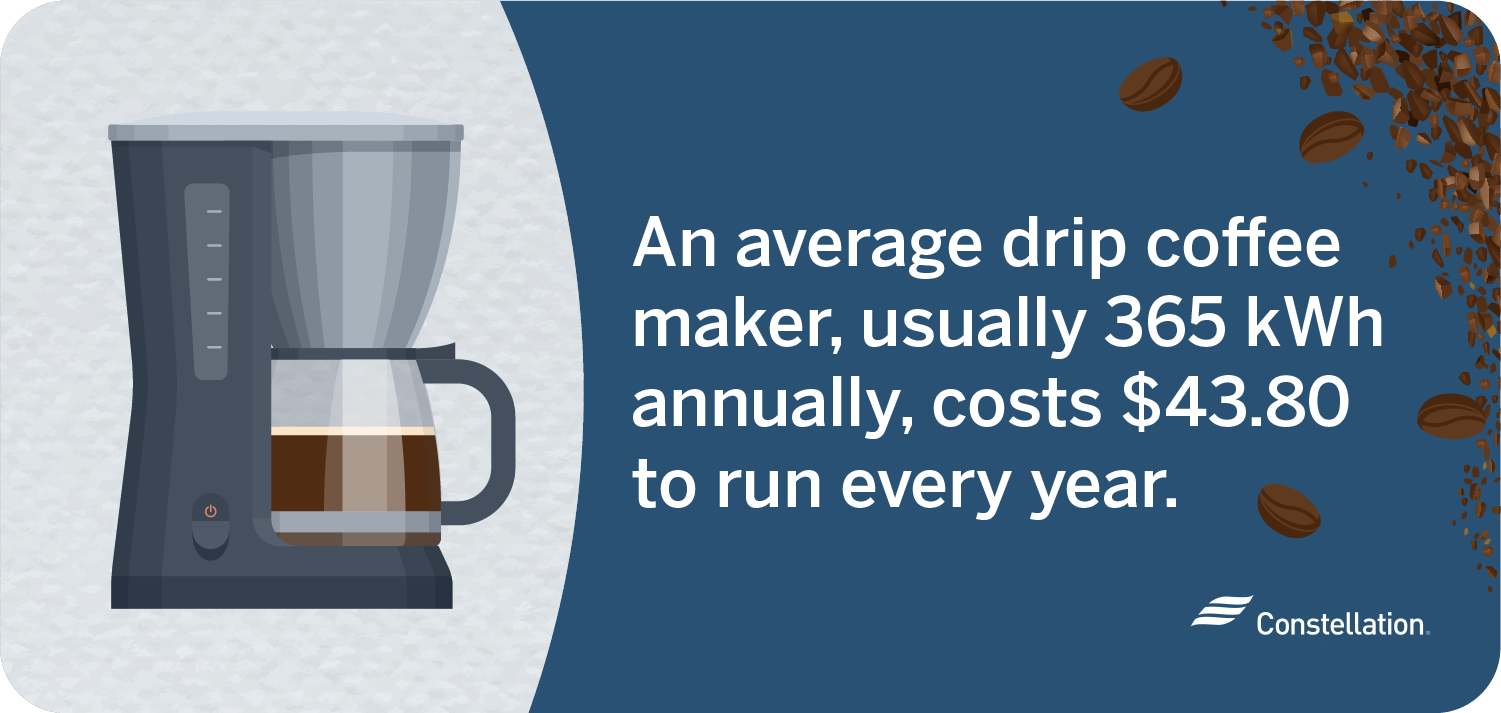
- Category:
Small Business Energy Savings -
Last updated:
April 16, 2025
Choosing the Best Office Coffee Maker
For many people, a good cup of coffee is essential at work. Beyond perking people up, hot coffee is one of the ways to keep warm at work. Investing in the best coffee maker for the office pays off in higher morale and productivity. Yet choosing the best office coffee machine can be daunting. You have hundreds of options and types of coffee makers to consider, with a dizzying array of features and functions. We will walk you through the basics of choosing a coffee maker for your business that will keep your employees well caffeinated.
What to consider when choosing a coffee maker for your office
Consideration of the five factors below can help cut through the complexity of finding the best coffee maker for the office. While similar to picking a coffee maker for your home, office coffee makers have to please more people, probably get used more often and need to make business sense.
1. Type of coffee maker
The first choice you will make is between the various types of coffee makers. You can find home size and industrial size versions of many of the most common coffee makers.

Different types of coffee makers for your business
-
- Automatic drip machines are the most common coffee maker type. They work by pouring a measured flow of hot water over ground coffee beans.
- Coffee pod brewing stations make fresh coffee one cup at a time on demand. They allow employees to choose their own flavors, but each pod is expensive.
- Espresso makers are a bit more complex, requiring users to operate the machines and froth their milk. Automatic espresso machines make the whole process easier, but they are expensive.
- Percolators are an old-fashioned option that once dominated coffee making. These machines boil water, which bubbles up and through a receptacle holding the grounds.
- French presses require employees to mix boiling water with grounds and then press the grounds to the bottom of the device, leaving the hot coffee fresh and ready to pour.
2. Number of employees in your office
The best office coffee machine will depend on the number of employees in your office. If you need to serve a crowd, for example, expensive coffee pods for individual brews are not practical. You might create a traffic jam as each employee goes through the process of pulling individual espressos. If you have a small office, however, some of those specialty machines may be appreciated.
3. Upfront and operational costs
Costs matter, and in situations where you have many people or heavy coffee drinkers, they can add up. The upfront cost of buying a coffee maker for the office is likely the lesser cost over the life of the machine. The cost of coffee and the energy to run the machine are a greater percentage of what you will end up paying to offer coffee in the office.
How much does it cost to run a coffee maker?
The cost to run a coffee maker depends on its power usage and the type of coffee maker chosen. While they all heat water up to 200 degrees Fahrenheit, they use different methods. A 1000 watt drip coffee maker takes about ten minutes to brew a pot. If you brew three pots a day, you are using .5 kilowatt-hours a day. Multiply that number by the number of days a year your office is occupied and then by your electricity rate to get an estimate of how much you will spend to run the machine. The government offers an online energy calculator to make estimating costs easy.

4. Ease of use
The energizing effect of coffee on employee productivity could add up to nothing if your staff has to waste time with a complex machine. Drip coffee makers dominate the market because they are so easy and reliably produce good-tasting coffee. A manual espresso machine takes a bit of skill and know-how and often creates a mess. It all adds up to time-consuming coffee making. Complex machines are also prone to breakage. Ease of use is clearly about more than just convenience.
5. Energy efficiency
The energy used to make coffee in your office is likely a bigger factor than purchase price in the overall cost of your office coffee machine. Choosing a type and a model that is energy efficient will help you keep your coffee budget in line and contribute to cutting your small business energy consumption.
Features to look for in an energy-efficient coffee maker
Small companies can enjoy the benefits of running an environmentally friendly business. It makes sense to put effort into choosing energy-efficient office equipment and that goes for office coffee makers, too. When choosing a coffee maker for your business, start by looking for the ENERGY STAR® logo and check its energy efficiency performance. The following features can also help you keep your coffee brewing energy costs down.
- Automatic power down. It is easy to waste energy by leaving the heating element on for hours after the coffee is brewed. Models that can be programmed to automatically shut off at a specified interval save money—and can prevent burning the coffee or damaging the carafe.
- Insulation. An insulated carafe keeps coffee hot without having to use energy to keep the heating element on.
- Flow-through water heaters. These mechanisms heat water as it passes through them. A coffee pod machine with a flow-through water heater is 50% more energy efficient than comparable models.
- Standby. Many coffee makers consume energy even when not in use. Those that are programmable stay in standby mode and those that have a clock are always drawing power. Unplug these models.
More energy saving tips for coffee makers
Beyond looking at how much energy does a coffee maker use and energy savings in the break room, consider these additional cost areas and ways to save:
- Reusable coffee pods. Reusable pods are a cost saver. Fill them with the ground coffee of your choice–or blend your own mix. After brewing a cup, rinse them out and use them again.
- Reusable coffee filters. Reusable coffee filters eliminate this expense and cut down on waste.
- Reusable cups/mugs. Eliminate paper cups and replace them with ceramic or glass alternatives.
- Turn off the burner. Keeping the burner on wastes energy and turns coffee bitter. It’s better to zap cold coffee in the microwave. You might want to put up office etiquette signs to save energy and remind people to turn off the coffee maker when the pot is nearly empty.
- Unplug your coffee pot or use a power strip. Unplug coffee makers that use standby power or plug them into a power strip to make it easier to cut power to them. Better yet, use a smart power strip you can program to turn off power to the machine.




